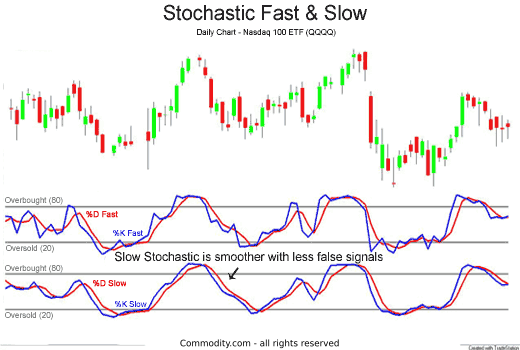What it is and what it shows
The Stochastic Oscillator provides readings that show the position of the current closing price relative to the high-low range over a defined number of periods.
The formula for the Stochastic Oscillator is as follows:
- %K = [(Current Close – Lowest Low) / (Highest High – Lowest Low)] x 100
- %D = 3-day SMA of %K
Usually, the Stochastic Oscillator is plotted as two lines:
- %K which is often referred to as the fast line
- %D which is a moving average of %K and can be termed as the slow line
When the Stochastic Oscillator has values above 80, it’s usually perceived as an overbought indication. On the flip side, a value below 20 might be seen as oversold. However, these thresholds can vary based on the asset’s inherent characteristics.
How to trade it
The Stochastic Oscillator offers multiple ways for traders to interpret its readings:
- Overbought and Oversold: When the Stochastic Oscillator exceeds 80, it can be seen as an indication that the security might be in an overbought condition. Conversely, a reading below 20 may indicate the asset is potentially oversold. It’s important to remember that just because the Stochastic Oscillator enters overbought or oversold areas, it doesn’t mean a reversal will occur immediately.
- Bullish and Bearish Divergences: These occur when the price action of a security differs from the movement of the Stochastic Oscillator. A bullish divergence is formed when the security records a lower low, but the Stochastic Oscillator forms a higher low. Conversely, a bearish divergence forms when the security records a higher high, but the oscillator forms a lower high.
- Stochastic Crossovers: A crossover is one of the primary trading signals of the Stochastic Oscillator. A bullish crossover occurs when the %K value crosses above the %D line, signaling potential upward momentum. A bearish crossover occurs when the %K value drops below the %D line, indicating potential downward momentum.
Example: If a forex pair has a reading of 85 on the Stochastic Oscillator, some traders might anticipate a potential bearish reversal, especially if other indicators confirm this sentiment.
Example: If a stock’s price creates a new low while the Stochastic Oscillator doesn’t reach its previous low, this could indicate decreasing downward momentum and a potential bullish reversal.
Example: If the %K line (fast line) crosses above the %D line (slow line) and both lines are below 20, it might be considered a bullish signal by some traders.
As always, it’s essential to utilize the Stochastic Oscillator in combination with other technical tools and analysis techniques. This ensures a more holistic view of the market and better-informed trading decisions.

